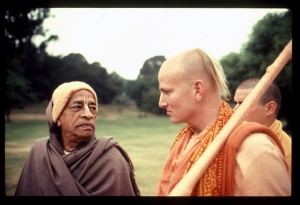CC Madhya 5.12 (1975)

A.C. Bhaktivedanta Swami Prabhupada
Below is the 1996 edition text, ready to be substituted with the 1975 one using the compile form.
TEXT 12
- vana-yātrāya vana dekhi’ dekhe govardhana
- dvādaśa-vana dekhi’ śeṣe gelā vṛndāvana
SYNONYMS
vana-yātrāya—in touring the different forests; vana dekhi’—while seeing the forests; dekhe—they see; govardhana—Govardhana Hill; dvādaśa-vana dekhi’—visiting the twelve forests in Vṛndāvana; śeṣe—at last; gelā—reached; vṛndāvana—Vṛndāvana.
TRANSLATION
After reaching Mathurā, they started visiting the different forests of Vṛndāvana and came to Govardhana Hill. They visited all twelve forests [vanas] and at last came to the town of Vṛndāvana.
PURPORT
The five forests situated on the eastern side of the river Yamunā are Bhadra, Bilva, Loha, Bhāṇḍīra and Mahāvana. The seven forests situated on the western side of the Yamunā are Madhu, Tāla, Kumuda, Bahulā, Kāmya, Khadira and Vṛndāvana. After visiting all these forests, these pilgrims went to a place known as Pañcakrośī Vṛndāvana. Out of the twelve forests, the Vṛndāvana forest extends from the town of Vṛndāvana up to Nanda-grāma and Varṣāṇā, a distance of thirty-two miles, within which the Pañcakrośī Vṛndāvana town is situated.